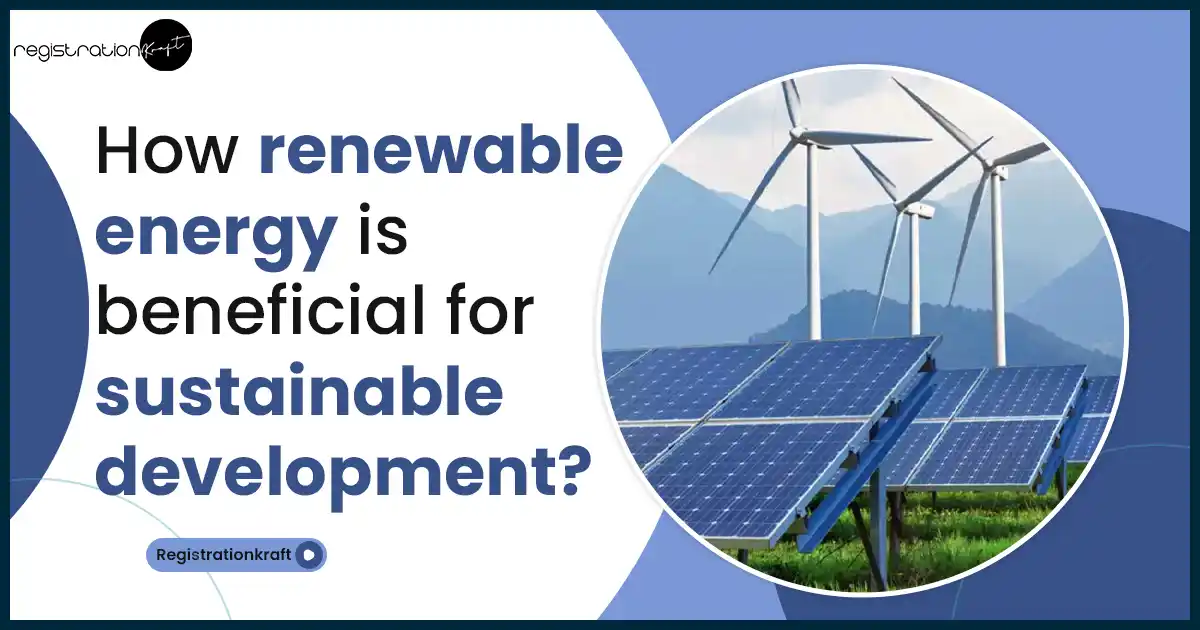There is no doubt that the world is moving at a fast pace but what is the cost we are paying to sustain this growth? Though the answer may vary greatly, most responders would raise their concern about the environment which is facing troubled times. Be it any part of the world, global warming has taken a toll on our environment glaciers are melting, global temperatures are soaring, air pollution increasing day by day, fossil fuels are on the verge of eloping, water getting contaminated, etc.
So, what’s the future ahead? According to experts, it is high time we should adopt renewable energy like never before. In fact, renewable energy should be a mainstay in all our chores at all levels. Let’s get to know why renewable energy can be a game changer by promoting sustainable development for today and tomorrow.
What is renewable energy?
Put simply, renewable energy refers to energy that is sourced from nature-based sources and it tends to be resinstated at a very fast rate than its consumption rate. One example of renewable energy is solar energy. Look at the different sides around you and you can easily notice the rate at which the world has been understanding the importance of leveraging renewable energy. From using solar-based electrical grids to running windmills, and using ocean power, there are several ways nature can help you find an alternative to what we do currently to meet our needs.
What are the different types of renewable energy?
Now, let’s delve deeper and understand the different types of renewable energy available around us.
Solar Energy
Solar energy is mainly known to be highly effective, adaptable, and strong. At present, there are two major options to leverage solar power: photovoltaics (PV), which is well suited for smaller-scale applications, and focused solar-thermal power (CSP), which is primarily meant for commercial or industrial applications. As we have discussed in previous post, Mr. Narendra Modi, Honorable Prime Minister of India launched the prestigious PM Surya Ghar Muft Bijli Yojana for Indian households on On February 13, 2024
The installation of solar panels presents a different set of challenges such as tree location, cloud crusade, weather, and more. To tackle these challenges, rapid technological enhancements are turning solar cells more malleable, lightweight, simpler to install, and affordable to generate by needing less space to get the required level or amount of light.
In the current scenario, solar energy is utilized across diverse sectors and applications. From smaller homes and businesses to large-scale commercial applications, solar panels and farms can be created on open land. Heavy power-reliant applications such as hospitals, data centers, manufacturing establishments, and airports are relying heavily on solar power to fulfill their energy needs.
Wind Energy
The newest type of wind turbine was developed in 1940 and since then, the technology behind has grown significantly. At present, wind turbines come in varying sizes to meet diverse types of needs. This type of renewable energy is considered an affordable way to get clean, sustainable energy for power generation. Regarding its impact on wildlife, wind power projects tend to lower ranks than other sources of power.
Though primarily used for power generation, contained wind power can also be used to mill grain and pump water. It can also deliver energy for electric vehicle charging stations.
Hydropower
The energy derived from water is known as hydropower. This energy is generated frm the movement of water. It is the biggest contributor of renewable electricity globally. It utilizes marine and tidal energy, rivers and streams, and dams to put turbines into action for power generation.
Apart from power generation, several industries utilize hydropower for numerous other chores. For instance, water is utilized in remote mining areas for extraction, and on-site hydropower systems may be used by textile and chemical businesses to power various processes like washing, fabrication, sanitation, and more.
Geothermal
Geothermal energy refers to the conversion of heat from within the Earth to generate power. The power generated this way is used in various industries. For instance, it delivers heat for agricultural greenhouses along with heating and cooling for production and food processing. This renewable energy is also utilized in air-conditioning commercial buildings such as schools, hospitals, and other establishments. Geothermal heat pumps (GHPs) are a great choice for smaller scale applications like household power.
Biomass energy
Biomass energy is taken from organic stuff and associated items that provide heat, produce electricity power and prepare biofuels including ethanol. These fuels are used in boilers to produce steam that is further used for power generation. Biomass energy is considered the best alternative to fossil fuels in transportation.
This type of renewable energy enables consistent power generation as compared to wind and solar energy. However, it may produce low levels of greenhouse gases that when combined with other environmental implications put doubt on the sustainability of biomass energy.
Nuclear Power
Though nuclear power generation employs unique and non-renewable uranium minerals, it is considered a type of energy that makes lower carbon emissions. And, the rapid advancements in nuclear power technologies have resulted in more energy-efficient nuclear power with lower carbon footprints. For example, the incorporation of small modular reactors (SMRs) tends to vary in size and can easily be used for applications like desalination, electricity generation, heating, and others.
How does renewable energy promote sustainable development?
The concept of sustainable development emerged in 1987 and was coined around a philosophy to adopt technologies and resources that are not meant to degrade the quality of lives for future generations.
Sustainable development inculcates various environmental, societal, and economic factors to pave way for the perfect balance while ensuring a better quality of life. Though sustainability is a long-standing goal, sustainable development may be inclusive of different approaches and strategies that can be smartly used to attain superior levels of sustainability.
Renewable energy has a direct relation with sustainable development. The effects of the usage of renewable energy resources on efficiency and societal development enable it to embrace newer opportunities in climate change reduction, clean energy accessibility, social and economic growth, reducing health and environmental effects, and energy security.
The Importance of Renewable Energy in the Future
Before we try to get an answer to this question, it is necessary to understand the renewable energy advantages below.
Renewable energy is cheaper
Renewable energy is considered the most affordable energy choice available in almost every corner of the world at present. Moreover, the adoption of newer technologies has further helped in the reduction of costs for renewable energy. For example, the cost of solar-based power got down by 85 percent between the year 2010 and 2020. Similarly, the cost of onshore and offshore wind energy reduced by 56 percent and 48 percent respectively.
This is one of the biggest reasons why renewable energy paves the way for a cleaner and affordable future for power-related needs. For middle and low-income nations, renewable energy is the easiest and cheapest way to meet their growing energy needs not just today but for future as well.
It is healthier
As per the World Health Organization (WHO), nearly 99 percent of individuals across the world inhale air that goes beyond air quality limits and damages their health. The study also indicates that over 13 million deaths happen worldwide every year are due to preventable environmental reasons.
The disastrous levels of very fine airborne pollutants and nitrogen dioxide emerge primarily from fossil fuels during burning. Embracing cleaner energy options such as solar and wind can helps not only in tackling climate change but also better air and well-being.
It is economical too
For a majority of developing nations that have limited resources, the initial cost can be exorbitant, and most of them will require financial and technical assistance to switch to renewable energy. However, spending on renewable energy will turn profitable in the long run. By 2030, just controlling pollution and its effects on the environment may save the world up to $4.2 trillion annually.
It is easily available
The sources of renewable energy are all around us and this makes them a viable alternative to fossil fuels. Take the example of solar energy and wind energy which enable people and businesses to switch to greener energy without worrying about supply and demand.
According to an estimation done by the International Renewable Energy Agency (IRENA), nearly 90% of the global electricity demand must be met through renewable energy sources. These sources present a great opportunity for developing nations for economic diversification, job growth, and poverty reduction.
The Conclusion
Considering the numerous advantages associated with renewable energy sources, it can be said that renewable energy holds the key to a sustainable and greener future for both developing and developed nations. It is high time both mid-size and large-scale industries adopt renewable energy sources to meet their ever-growing power needs.

